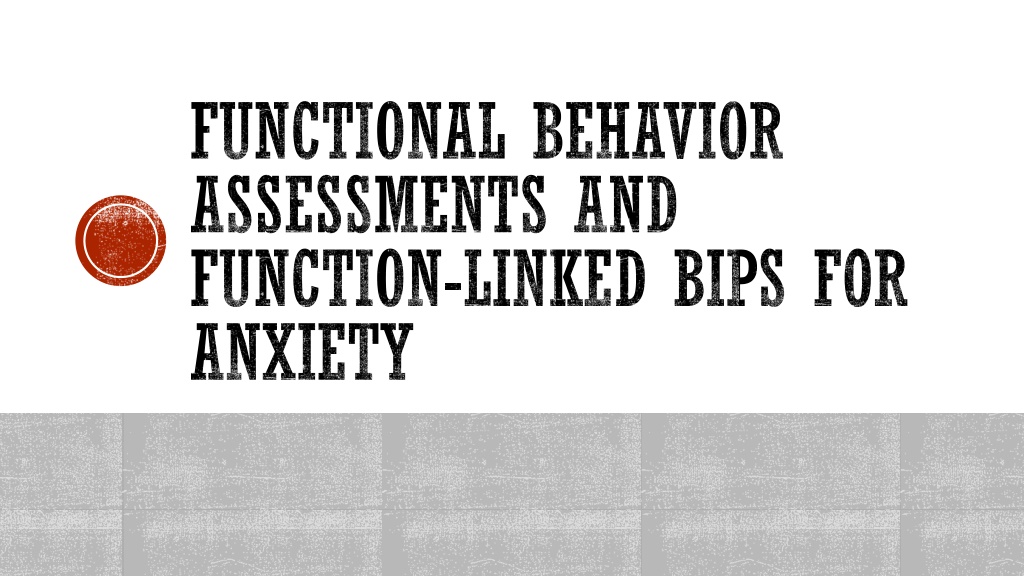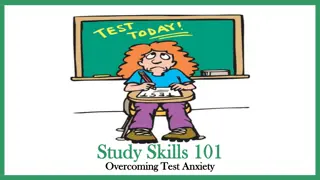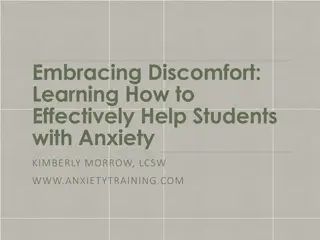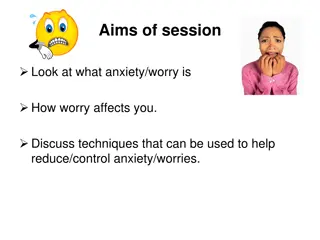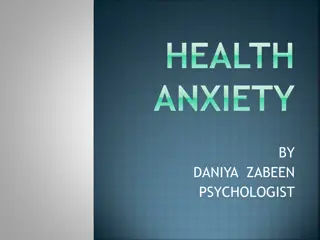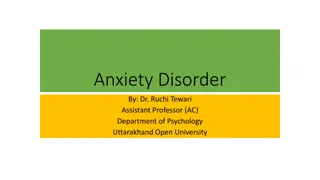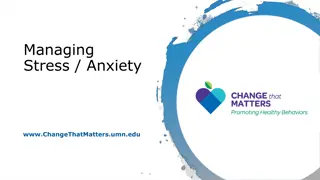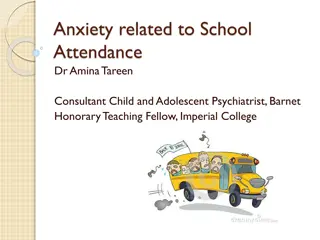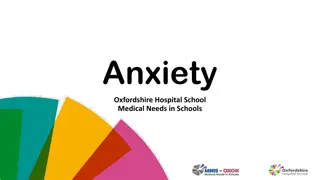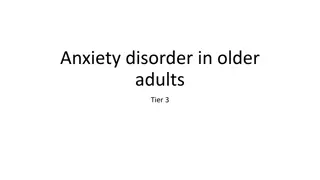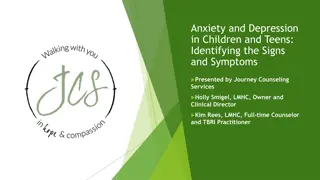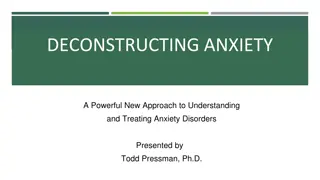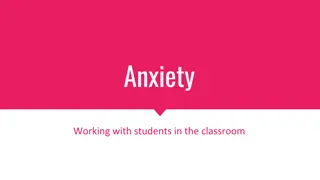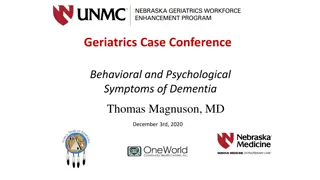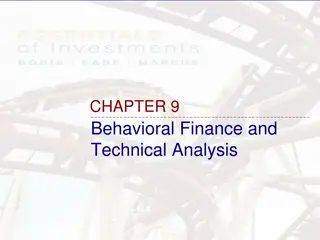Understanding Setting Events in Behavioral Assessments for Anxiety
Functional Behavior Assessments (FBAs) and Behavior Intervention Plans (BIPs) play a crucial role in addressing anxiety issues in students. By identifying setting events and antecedents, teachers can develop prevention strategies, teach replacement behaviors, and provide reinforcement tailored to manage anxiety-related behaviors effectively. Setting events act as triggers for immediate behavior responses and understanding their role is essential for developing successful interventions.
Download Presentation

Please find below an Image/Link to download the presentation.
The content on the website is provided AS IS for your information and personal use only. It may not be sold, licensed, or shared on other websites without obtaining consent from the author. Download presentation by click this link. If you encounter any issues during the download, it is possible that the publisher has removed the file from their server.
E N D
Presentation Transcript
FUNCTIONAL BEHAVIOR ASSESSMENTS AND FUNCTION-LINKED BIPS FOR ANXIETY
FBA/BIP AND STUDENTS WITH ANXIETY An FBA and BIP can: identify the setting events and immediate antecedents that predict anxiety so that a prevention intervention can be developed and implemented Teach the student replacement behaviors to perform when anxiety is present-both functional equivalent replacement behaviors (ask for a delay, break) and desired, alternative skills (self-regulation, replacing thoughts) Develop reinforcement strategies for performance of the replacement behaviors rather than behavioral criteria that can be impacted by fluctuating anxiety episodes
SETTING EVENTS-REFRESHER Antecedent (push) Setting event antecedents distal (removed in time from push to perform problem behavior)- hours to days Sets the chain of the immediate trigger, problem behaviors, & responses to behavior in motion Not a permanent state Fluctuating data
Teacher presents demand to do a non- preferred task, specifically independent writing assignment in language arts Previous evening, mom takes away electronics from Trevor as a consequnce for talking back As a result, he delays having to do the non- preferred task Trevor has a tantrum Teacher presents demand to do a non- preferred task, specifically independent writing assignment in language arts Trevor does the independent assignment and has approprite behavior Previous evening, Trevor keeps electronic privileges
WHAT IS NOT A SETTING EVENT? It is not the setting Not hallway, classroom, playground It is not present every day-malleable (occur sometimes and not other times) Not permanent, stable events - ADHD, Autism, divorced parents, death of family member, moving to a new locations, etc.
HOW DO SETTING EVENT WORK? Delayed impact on behavior Temporarily change the value of the consequence or reinforcer Example: Susan has been a star student (engaged, respectful, responsible intrinsically reinforced, teacher pleaser) Susan has joined a sports team (soccer) At least 3 times a week, Susan has a game scheduled in the evening Susan gets to bed late those nights and only gets 5 hours of sleep Susan is fatigued at school and is less engaged and falls asleep during tasks to avoid work Sleep deprivation sets the occasion -avoiding work becomes more reinforcing than completing tasks
FUNCTIONAL THINKING Most often, escape or avoidance Not always obvious Student asks to go to the nurse before a writing assignment-more obvious Student cussing, putting head down during math test and teacher responds by sending to office, inadvertently reinforces avoidance behavior
EXAMPLE Quentin Fifth grade student with anxiety Writing is a non-preferred task Writing is difficult at a fifth grade level-specifically when task requires inferential thinking Sometimes, when writing is assigned Quentin will engage in the task and complete the assignment Other days, Quentin will engage in off-task behaviors (e.g., tap peers on the shoulders to talk to them, leave seat and walk around the room, break pencil, ask to go to the restroom or nurse) On those days, Quentin will perform problem behaviors during tasks that he likes Teacher states behavior seems to occur out of the blue In this case, Quentin may be experiencing high anxiety on the day of the problem behaviors.
TRADITIONAL CONSEQUENCE-BASED PLANS-WHY NOT JUST USE THEM? Tokens, points, stickers, edibles may not be effecive Criteria for earning based on performance when not anxious Fluctuating state not considered (Minahan & Rappaport, 2012). Competing reinforcement Anxiety is competing and the function (e.g., escape anxious situation, get soothing/comfort) stronger
SOME REPLACEMENT SKILLS FOR STUDENTS WITH ANXIETY Ask for a break or for soothing Recognize and manage anxiety Self-regulation-calm self Thought stopping/thought interruption-positive psychology-replacing negative thoughts with positive replacement thoughts Executive functioning-think prior to acting; intrinsic reinforcement; censoring behaviors; follow steps to achieve an outcome
GATHERING FBA INFORMATION FOR ANXIETY-DEFINING BEHAVIOR Don t define as anxious or anxiety Operationalize behaviors performed when anxious Pre-cursor behaviors that indicate an anxious condition
OPERATIONALIZING BEHAVIORS ACTIVITY Think about something that makes you anxious Describe your behaviors when you are anxious Define them (physical behaviors, verbal behaviors observed by others) Share
GATHERING FBA INFORMATION FOR ANXIETY Interviews and observations Identify antecedents situations, circumstances, events, etc. that are anxiety-provoking for the student (e.g., routines, activities)-contrast with low-anxiety provoking routines Consider setting events contribute toward the student s anxiety (e.g., events that happen at home, earlier in the day, the previous evening, physiological states, infrequent but anxiety provoking events at school such as major test, social event, etc.)-events that when in place, set the stage for the target problem behavior Identify the consequences/responses e.g., escapes by going to the nurse or home, avoids or delays a task, gets attention and help, gets calming/soothing, etc.) Common FBA interviews can be used-add additional questions Interview the student! Develop the hypothesis
EXAMPLE OF HYPOTHESES When Ben s parents are out of town and Ben stays with another adult, and when at school, he is asked to do non-preferred tasks that are lengthy or when required to take a test, he will put his head down on his desk. As a result, he gets to escape the non-preferred task and secondarily gets attention from the teacher. When Miguel arrives at school in an anxious state (e.g., fingers are twitching, foot is shaking non-stop while sitting) and is asked to do an activity that requires social interaction with other students, he will report an illness (e.g., stomach-ache, headache) and request to see the nurse. As a result, he escapes socially interacting with students. When Laura is given a math assignment involving multiple digit division, she will scratch at her hands until they get red and bleed. As a result, she accesses attention and self-soothing of anxiety and secondarily avoids doing the math activity.
EXAMPLE OF BEHAVIOR INTERVENTIONS LINKED TO HYPOTHESES When Ben s parents are out of town and Ben stays with another adult, and he is asked to do non-preferred tasks that are lengthy or when required to take a test, he will put his head down on his desk. As a result, he gets to escape the non-preferred task and secondarily gets attention from the teacher. Prevention interventions: Setting Event Modification-Set up a communication system with the family to be notified on the days that Ben s parent will be out of town. On those days, Ben will be provided choices when presented with the non-preferred tasks including (a) choosing the amount he will do; (b) choosing if he will do some of it now and some of it later; or (c) if the teacher observes that Ben s anxiety is high, allowing him to choose to do the assignment or go to the counselor for 10 minutes to talk/CBI.
EXAMPLE OF BEHAVIOR INTERVENTIONS LINKED TO HYPOTHESES When Ben s parents are out of town and Ben stays with another adult, and he is asked to do non-preferred tasks that are lengthy or when required to take a test, he will put his head down on his desk. As a result, he gets to escape the non-preferred task and secondarily gets attention from the teacher. Replacement behavior: Teach Ben to ask for an escape-selecting from break passes that indicate different times (5 min., 10 min., 15 min.) or ask to see the counselor for CBI Teach Ben strategy to appropriately reduce the anxiety he has (e.g., stress relievers, etc.)
EXAMPLE OF BEHAVIOR INTERVENTIONS LINKED TO HYPOTHESES When Ben s parents are out of town and Ben stays with another adult, and he is asked to do non-preferred tasks that are lengthy or when required to take a test, he will put his head down on his desk. As a result, he gets to escape the non-preferred task and secondarily gets attention from the teacher. Reinforcement: Each time Ben uses a break pass, he gets a break from the task for the requested amount of time Each time Ben uses his anxiety reduction strategy, natural reinforcement (reduction), gets positive praise/comments and time away (total escape or proportional time) from non-preferred task and gets to do a preferred task in exchange.
